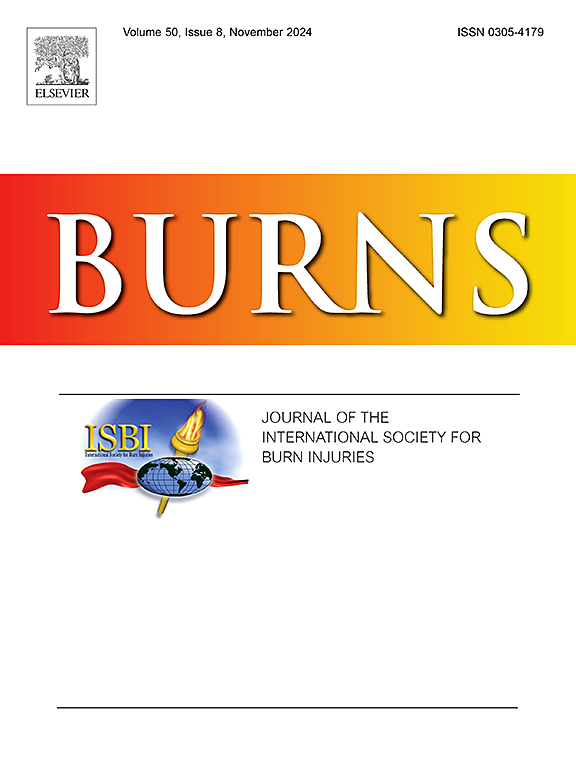Understanding benefit finding among burn survivors: A latent profile analysis study
IF 3.2
3区 医学
Q2 CRITICAL CARE MEDICINE
引用次数: 0
Abstract
Objective
This study aimed to utilize Latent Class Analysis to identify distinct benefit finding traits among burn survivors, analyze the differences in benefit finding between subgroups based on their demographic and clinical characteristics, and explore the variables that are associated with these distinct patterns.
Method
From June 2022 to December 2023, a self-reported cross-sectional survey was conducted in Northeast China to investigate benefit finding among burn survivors. The survey included measures of demographic, clinical, specific emotion, and social isolation variables. Latent Class Analysis was used to identify benefit finding profiles, which were then described and compared based on these variables. Furthermore, associations between these profiles and both expressivity and social isolation were analyzed using multinomial logistic regression.
Results
Among 147 burn survivors, three benefit finding subgroups emerged from Latent Class Analysis, Class A (65 [44.21%]), Class B (45 [30.61 %]) and Class C (37 [25.17 %]). Class A was the low benefit finding and adjustment difficulties group, Class B was the moderate level of benefit finding group, and Class C was the high level of benefit finding and perception of being loved group. Compared to Class B and C, post-burn survivors of Class A were more likely to experience adverse patient reported outcomes, specifically, lower family monthly income per capita, post-burn duration, difficulties in emotion expression, and social isolation (p < 0.05 for all). Clinical burn nursing staff should prioritize their attention on patients who exhibit low benefit finding and weakened coping abilities during post-burn rehabilitation. Additionally, it is crucial to encourage these patients to express their true feelings related to their disease experience. By improving their awareness of available social support and providing additional social resources, clinical burn nursing staff can help enhance these patients' sense of benefit finding from their disease experience.
Conclusion
Latent Class Analysis identified three distinct benefit-finding profiles among post-burn survivors. These results suggest that post-burn survivors' perceptions of benefit finding vary significantly, exhibiting individual differences. Health care providers should consider patients' emotions as well as their social support networks when developing interventions for patients with a low degree of benefit-finding. Targeted interventions should be developed and implemented based on the characteristics of each benefit-finding class to maximize the effectiveness of these interventions.
了解烧伤幸存者的获益发现:一项潜在剖面分析研究
目的本研究旨在利用潜在分类分析(Latent Class Analysis)识别烧伤幸存者不同的获益发现特征,分析基于其人口学和临床特征的亚组之间的获益发现差异,并探讨与这些不同模式相关的变量。方法自2022年6月至2023年12月,在中国东北地区进行一项自我报告的横断面调查,调查烧伤幸存者的获益情况。该调查包括人口统计、临床、特定情绪和社会孤立变量的测量。潜在类别分析用于确定效益发现概况,然后根据这些变量对其进行描述和比较。此外,使用多项逻辑回归分析了这些特征与表达能力和社会隔离之间的关系。结果147例烧伤幸存者中,潜在分类分析中出现了3个获益亚组,A类(65例[44.21%])、B类(45例[30.61 %])和C类(37例[25.17 %])。A类为低利益寻找和适应困难组,B类为中等利益寻找水平组,C类为高利益寻找和被爱感知水平组。与B类和C类相比,A类烧伤幸存者更有可能经历不良的患者报告结果,特别是家庭人均月收入较低、烧伤后持续时间较长、情绪表达困难和社会孤立(p均为 <; 0.05)。临床烧伤护理人员应优先关注在烧伤后康复过程中表现出低获益感和较弱应对能力的患者。此外,鼓励这些患者表达他们与疾病经历相关的真实感受是至关重要的。通过提高患者对现有社会支持的认识和提供额外的社会资源,临床烧伤护理人员可以帮助增强这些患者从疾病经历中获益的意识。结论:潜在分类分析在烧伤幸存者中发现了三种不同的获益谱。这些结果表明,烧伤后幸存者对利益发现的看法差异很大,表现出个体差异。在为获益程度低的患者制定干预措施时,卫生保健提供者应考虑患者的情绪以及他们的社会支持网络。应根据每个受益阶层的特点制定和实施有针对性的干预措施,以最大限度地提高这些干预措施的有效性。
本文章由计算机程序翻译,如有差异,请以英文原文为准。
求助全文
约1分钟内获得全文
求助全文
来源期刊

Burns
医学-皮肤病学
CiteScore
4.50
自引率
18.50%
发文量
304
审稿时长
72 days
期刊介绍:
Burns aims to foster the exchange of information among all engaged in preventing and treating the effects of burns. The journal focuses on clinical, scientific and social aspects of these injuries and covers the prevention of the injury, the epidemiology of such injuries and all aspects of treatment including development of new techniques and technologies and verification of existing ones. Regular features include clinical and scientific papers, state of the art reviews and descriptions of burn-care in practice.
Topics covered by Burns include: the effects of smoke on man and animals, their tissues and cells; the responses to and treatment of patients and animals with chemical injuries to the skin; the biological and clinical effects of cold injuries; surgical techniques which are, or may be relevant to the treatment of burned patients during the acute or reconstructive phase following injury; well controlled laboratory studies of the effectiveness of anti-microbial agents on infection and new materials on scarring and healing; inflammatory responses to injury, effectiveness of related agents and other compounds used to modify the physiological and cellular responses to the injury; experimental studies of burns and the outcome of burn wound healing; regenerative medicine concerning the skin.
 求助内容:
求助内容: 应助结果提醒方式:
应助结果提醒方式:


